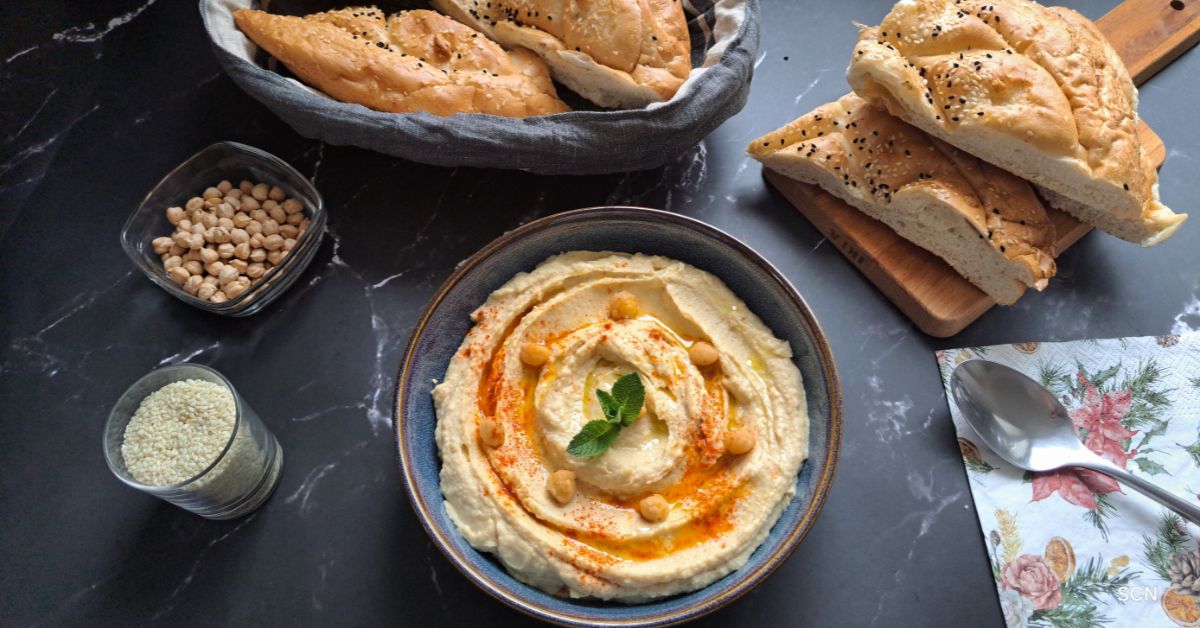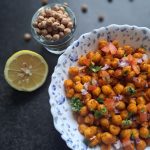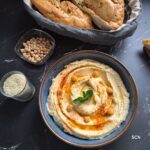Hummus

Have you ever tried hummus? It’s a tasty and healthy food that many people enjoy all around the world. Hummus comes from the Middle East, where it has been eaten for a long, long time. But nowadays, you can find it in lots of different places, from fancy restaurants to your local grocery store.
Hummus is made from chickpeas and other yummy ingredients like tahini (which is made from sesame seeds), olive oil, lemon juice, and garlic. These ingredients are all mixed to make a smooth and creamy spread that’s perfect for dipping or spreading on bread.
One of the best things about hummus is how versatile it is. You can eat it with veggies like carrots and cucumbers, or you can spread it on sandwiches and wraps. Some people even use it as a topping for grilled meats or salads!
Not only it is delicious, but it’s also good for you. Chickpeas are packed with protein and fibre, which help keep you feeling full and satisfied. Plus, the other ingredients in hummus are full of vitamins and minerals that your body needs to stay healthy.
Do I have to remove the skin of chickpeas?
Removing the skin from chickpeas when making hummus isn’t strictly necessary, but doing so can result in a smoother texture. The skins can add a slightly grainy texture to the finished hummus, so some people prefer to remove them for a creamier consistency. However, if you’re short on time or don’t mind a slightly coarser texture, you can certainly leave the skins on. It ultimately comes down to personal preference.
Aquafaba is the viscous liquid leftover from cooking legumes, most commonly chickpeas. It is rich in protein and starches leached from the beans during cooking. Canned chickpeas often come packed in a liquid called aquafaba. This viscous liquid can be drained and reserved for later use.
Check this healthy and quick snack with chickpeas.



Hummus
Ingredients
1 cup = 250ml
Tahini paste
- 1 cup white sesame seeds 120g
- 4 – 5 tbsp of neutral flavoured oil
- Pinch of salt optional
Hummus
- 1 cup chickpeas
- ¼ tsp baking soda optional
- 1 garlic clove
- 2 tbsp olive oil plus more for serving
- ¼ cup lemon juice
- ½ tsp cumin powder
- ¼ cup stirred tahini paste sesame seed paste
- 3 to 5 tablespoons of chilled water or aquafaba see notes
- Salt
- Paprika or sumac for serving
Instructions
Tahini Paste
- Place the sesame seeds in a dry skillet over medium heat. Toast them, stirring frequently, until they turn golden brown and become fragrant. Be careful not to let them burn.
- Transfer the toasted sesame seeds to a plate and let them cool completely. They need to be at room temperature before you proceed.
- Once the sesame seeds have cooled, transfer them to a food processor or high-speed blender. Blend them on high speed until they form a thick, crumbly paste. This may take a few minutes, and you may need to stop and scrape down the sides of the bowl or blender jar occasionally.
- With the food processor or blender running, gradually add the oil, starting with 2 tablespoons. Blend until the mixture becomes smooth and creamy. You can add more oil as needed to achieve your desired consistency. The tahini should be thick but pourable.
- Taste the tahini and add a pinch of salt if desired. Blend again briefly to incorporate the salt.
- Transfer the tahini paste to a clean jar or airtight container. It can be stored in the refrigerator for up to a month. Before using, stir it as it may separate slightly over time.
Hummus
- Place the dried chickpeas in a large bowl and cover them with water. Let the chickpeas soak overnight or for at least 6 hours.
- After soaking, drain and rinse the chickpeas. Place the soaked and drained chickpeas in the pressure cooker. Add enough water to cover the chickpeas by about 1 inch. If desired, add baking soda to help soften the chickpeas. Baking soda is optional but can reduce cooking time and result in softer chickpeas.
- Once the cooking time is complete, allow the pressure to release naturally. This means letting the pressure cooker sit undisturbed until the pressure valve drops on its own.
- Carefully open the pressure cooker lid. The chickpeas should be tender and easily squished between your fingers. If they’re still firm, you can cook them under pressure for a few more minutes.
- Skim off any foam that forms on the surface during cooking. Once cooked, drain the chickpeas, reserving some of the cooking liquid. (Aquafaba)
- They are now ready to be used in your favourite recipes, including hummus!
- In a food processor or blender, combine the boiled/canned chickpeas, tahini, lemon juice, minced garlic, olive oil, cumin, and a pinch of salt.
- Blend the mixture until smooth and creamy. If the hummus is too thick, you can add aquafaba or ice cubes, 1 tablespoon at a time, until you reach your desired consistency.
- Taste the hummus and adjust the seasoning as needed. You can add more salt, lemon juice, or garlic to suit your taste preferences.
- Once the hummus is smooth and well-seasoned, transfer it to a serving bowl.
- Drizzle some extra virgin olive oil on top of the hummus and sprinkle with optional toppings such as chopped parsley, paprika or sumac.
- Serve the hummus with pita bread, fresh vegetables, or your favourite crackers for dipping. Enjoy!
Notes

1 thought on “Hummus”